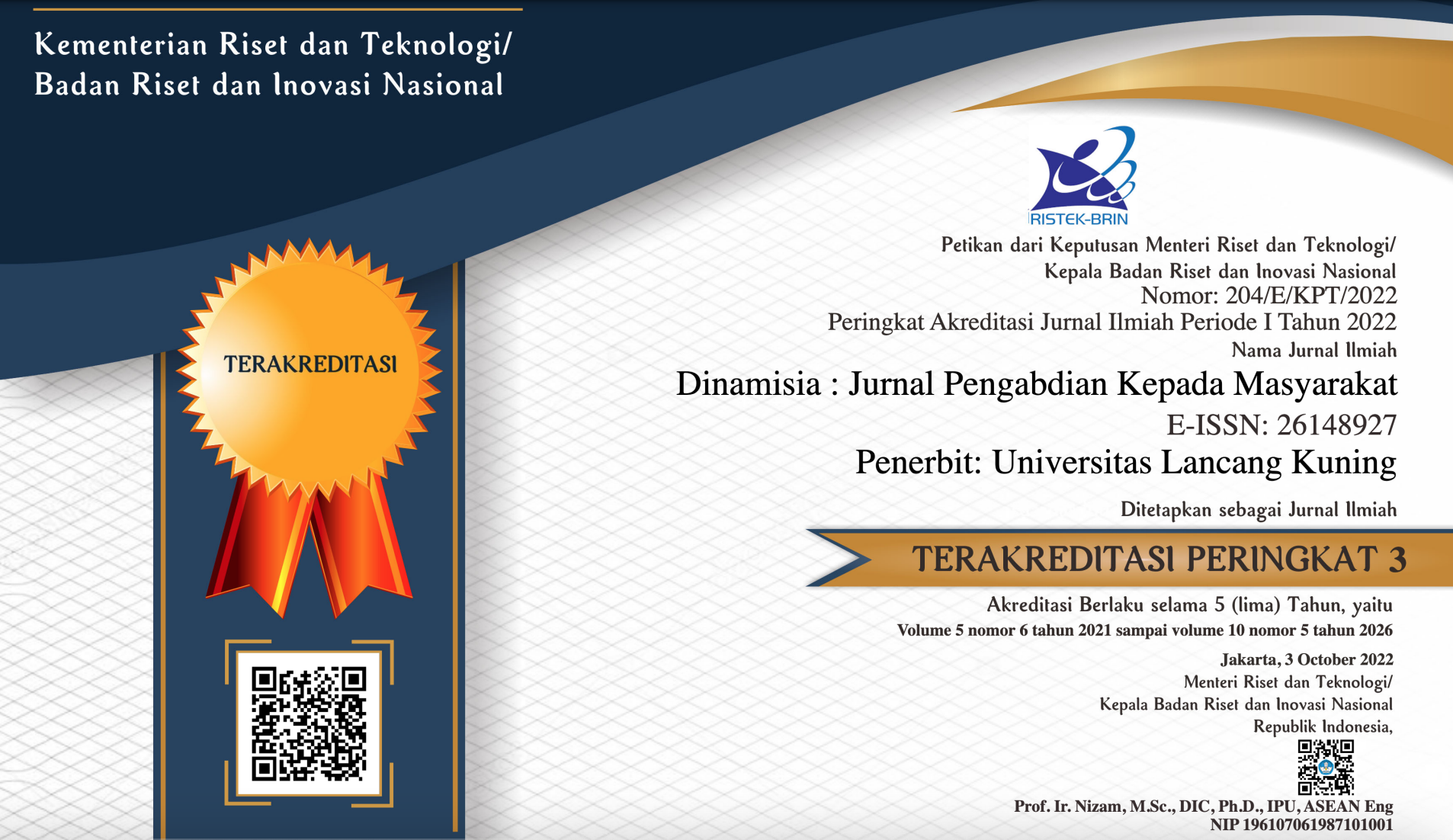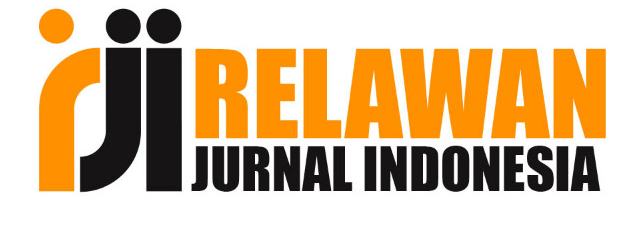Pelatihan Dan Pendampingan Evaluasi Website Menggunakan Sortsite 5.3.5 Pada Website “Mal Pelayanan Publik” Dinas Penanaman Modal Dan Pelayanan Terpadu Satu Pintu Kota Samarinda
Abstract
The use of the website as a means to bring public services closer to the community is indeed a must for the government in the digital era. The website plays an important role as a medium for the government to disseminate public information. Therefore, government websites that are built and funded through public funds must be able to reach all levels of society and have good performance. Based on that, this Community Service Program seeks to make a small contribution to the Samarinda City Government, especially the Samarinda City DPMPTSP related to training and assistance in evaluating the Public Service Mall website using SortSite 5.3.5. The implementation of the Community Service Program starts from the stages of problem identification, verification, provision of materials, implementation of training and mentoring and evaluation of activities. Based on the observation, it can be said that the training and mentoring program has successfully increase the skill and knowledge of DPMPTSP website operator.
Keywords: Training, Mentoring, Website Evaluation, Samarinda City DPMPTS
Downloads
References
Aladwani, A. M. (2016). Corruption as a source of e-Government projects failure in developing countries: A theoretical exposition. International Journal of Information Management, 36(1), 105–112. https://doi.org/10.1016/j.ijinfomgt.2015.10.005
Alismail, S., & Chipidza, W. (2021). Accessibility evaluation of COVID-19 vaccine registration websites across the United States. Journal of the American Medical Informatics Association, 28(9), 1990–1995. https://doi.org/10.1093/JAMIA/OCAB105
Aprilia, S., Wijaya, A., & Suryadi, S. (2014). Efektivitas Website Sebagai Media E-Government dalam Meningkatkan Pelayanan Elektronik Pemerintah Daerah (Studi Pada Website Pemerintah Daerah Kabupaten Jombang). Wacana, Jurnal Sosial Dan Humaniora, 17(3), 126–135. https://doi.org/10.21776/ub.wacana.2014.017.03.3
Ayuningtyas, A., Yuliani Indrianingsih, & Uyuunul Mauidzoh. (2020). Pengenalan, Optimalisasi Optimalisasi Pengenalan Produk Unggulan Desa Melalui Pelatihan Website Promosi Kecamatan Patuk Gunungkidul. Dinamisia : Jurnal Pengabdian Kepada Masyarakat, 4(3), 490–495. https://doi.org/10.31849/dinamisia.v4i3.3782
Choi, H., Park, M. J., Rho, J. J., & Zo, H. (2014). Rethinking the assessment of e-government implementation in developing countries from the perspective of the design–reality gap: Applications in the Indonesian e-procurement system. Telecommunications Policy, 40(7), 644–660. https://doi.org/10.1016/j.telpol.2016.03.002
Damanik, M. P., & Purwaningsih, E. H. (2017). E-GOVERNMENT DAN APLIKASINYA DI LINGKUNGAN PEMERINTAH DAERAH (Studi Kasus Kualitas Informasi Website Kabupaten Bengkalis Propinsi Riau). Jurnal Studi Komunikasi Dan Media, 21(2), 151–164.
Djoni, Yunis, R., & Ariwibowo, S. (2021). Penguatan Promosi Melalui Media Website pada Hotel Alvina Pematangsiantar. Dinamisia : Jurnal Pengabdian Kepada Masyarakat, 5(3), 772–782. https://doi.org/10.31849/dinamisia.v5i3.6287
Effendi, P. M., & Susanto, T. D. (2019). Test of citizens’ physical and cognitive on Indonesian e-government website design. Procedia Computer Science, 161, 333–340. https://doi.org/10.1016/j.procs.2019.11.131
Elkadi, H. (2013). Success and failure factors for e-government projects: A case from Egypt. Egyptian Informatics Journal, 14(2), 165–173. https://doi.org/10.1016/j.eij.2013.06.002
Elling, S., Lentz, L., de Jong, M., & van den Bergh, H. (2012). Measuring the quality of governmental websites in a controlled versus an online setting with the “Website Evaluation Questionnaire.” Government Information Quarterly, 29(3), 383–393. https://doi.org/10.1016/j.giq.2011.11.004
Gharibeniazi, M., Kamran, M. K. A., & Ghaebi, A. (2015). Iranian state university websites. International Journal of Information Science and Management, 13(1), 71–85.
Guijarro, L. (2007). Interoperability frameworks and enterprise architectures in e-government initiatives in Europe and the United States. Government Information Quarterly, 24(1), 89–101. https://doi.org/10.1016/j.giq.2006.05.003
Irawan, B., & Hidayat, M. N. (2020). Evaluasi aksesibilitas website covid19.kaltimprov.go.id menggunakan sortsite 5.3.5. Jurnal Paradigma, 9(2), 119–130. https://doi.org/http://dx.doi.org/10.52239/jp.v9i2
Irawan, B., & Hidayat, M. N. (2021). Asistensi Pembuatan Website “Mall Pelayanan Publik” Dinas Penanaman Modal Dan Pelayanan Terpadu Satu Pintu Kota Samarinda. Dinamisia : Jurnal Pengabdian Kepada Masyarakat, 5(5), 1120–1128. https://doi.org/10.31849/dinamisia.v5i5.7766
Irawan, B., & Hidayat, M. N. (2022). Evaluating Local Government Website Using a Synthetic Website Evaluation Model. 20(1), 449–470.
Irawan, B., Hidayat, M. N., Akbar, P., & Khanz, A. H. (2020). Inovasi Pelayanan Permohonan Pengajuan Izin Dinas Penanaman Modal dan Pelayanan Terpadu Satu Pintu (DPMPTSP) Kota Samarinda. Matra Pembaruan, 4(2), 135–145. https://doi.org/10.21787/mp.4.2.2020.135-145
Ismail, A., & Kuppusamy, K. S. (2019). Web accessibility investigation and identification of major issues of higher education websites with statistical measures: A case study of college websites. Journal of King Saud University - Computer and Information Sciences, xxxx. https://doi.org/10.1016/j.jksuci.2019.03.011
Kanter, C., & Purnama, A. (2015). Peran Website Pemerintah Kota Manado Dalam Mendukung Terwujudnya Good Governance. Jurnal Penelitian Komunikasi Dan Opini Publik, 19(3), 123272.
Karkin, N., & Janssen, M. (2014). Evaluating websites from a public value perspective: A review of Turkish local government websites. International Journal of Information Management, 34(3), 351–363. https://doi.org/10.1016/j.ijinfomgt.2013.11.004
Kesswani, N., & Kumar, S. (2016). Accessibility analysis of websites of educational institutions. Perspectives in Science, 8, 210–212. https://doi.org/10.1016/j.pisc.2016.04.031
Kondoro, A., & Mtebe, J. (2017). Accessibility and Usability of Government Websites in Tanzania. The African Journal of Information Systems, 9(4), 262. http://196.44.162.10:8080/xmlui/handle/20.500.11810/4573
Kurniawan, F., Rakhmawati, N. A., Abadi, A. N., Zuhri, M., & Sugiyanto, W. T. (2017). Indonesia local government information completeness on the web. Procedia Computer Science, 124, 21–28. https://doi.org/10.1016/j.procs.2017.12.125
Masyhur, F. (2014). Kinerja Website Resmi Pemerintah Provinsi di Indonesia. Pekommas, 17(1), 9–14. http://download.portalgaruda.org/article.php?article=266814&val=6557&title=Kinerja Website Resmi Pemerintah Provinsi di Indonesia
Menggo, S., Rosdiana Su, Y., & Taopan, R. A. (2022). Pelatihan Pembuatan Website Desa Wisata di Desa Wisata Meler, Kabupaten Manggarai NTT. DINAMISIA: Jurnal Pengabdian Kepada Masyarakat, 6(1), 108–115.
Riki Afriansyah. (2020). Pembuatan Portal Website Sekolah Sma Negeri 1 Sungailiat Sebagai Media Informasi. Dinamisia : Jurnal Pengabdian Kepada Masyarakat, 5(1), 154–160. https://doi.org/10.31849/dinamisia.v5i1.4413
Rinaldi, H., & Yuardani, A. M. (2015). Analisis Peluang Transformasi “E-Government” menjadi “E-Democracy”melalui Website Resmi Pemerintah Daerah. MIMBAR, Jurnal Sosial Dan Pembangunan, 31(1), 103. https://doi.org/10.29313/mimbar.v31i1.1201
Schuppan, T. (2009). E-Government in developing countries: Experiences from sub-Saharan Africa. Government Information Quarterly, 26(1), 118–127. https://doi.org/10.1016/j.giq.2008.01.006
Sherafat, A., & Davoodi, S. M. R. (2018). Designing a new model for organizational websites evaluation. International Journal of Information Science and Management, 16(1), 49–69.
Veeramootoo, N., Nunkoo, R., & Dwivedi, Y. K. (2018). What determines success of an e-government service? Validation of an integrative model of e-filing continuance usage. Government Information Quarterly, 35(2), 161–174. https://doi.org/10.1016/j.giq.2018.03.004
Venkatesh, V., Hoehle, H., & Aljafari, R. (2014). A usability evaluation of the Obamacare website. Government Information Quarterly, 31(4), 669–680. https://doi.org/10.1016/j.giq.2014.07.003
Verkijika, S. F., & De Wet, L. (2018). A usability assessment of e-government websites in Sub-Saharan Africa. International Journal of Information Management, 39(September 2017), 20–29. https://doi.org/10.1016/j.ijinfomgt.2017.11.003
Wahid, F. (2008). Evaluating Focus and Quality of Indonesian E-Government Websites. Seminar Nasional Aplikasi Teknologi Informasi, 2008(Snati), 39–43.
Wanti, L. P., Romadloni, A., Ikhtiagung, G. N., & Adi, N. W. (2022). Pemanfaatan Teknologi Informasi untuk Pengembangan Desa Wisata Widarapayung Wetan melalui Pemberdayaan Kelompok Sadar Wisata ( Pokdarwis ). 6(1), 128–135.
Yunita, N. P., & Aprianto, R. D. (2018). Kondisi Terkini Perkembangan Pelaksanaan E-Government di Indonesia: Analisis Website. Seminar Nasional Teknologi Informasi Dan Komunikasi, 2018(Sentika), 23–24. https://fti.uajy.ac.id/sentika/publikasi/makalah/2018/40.pdf



















